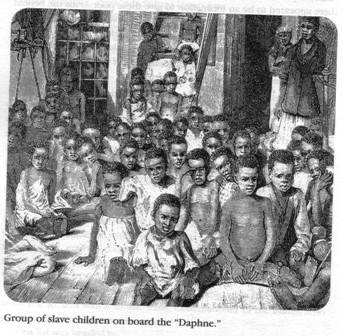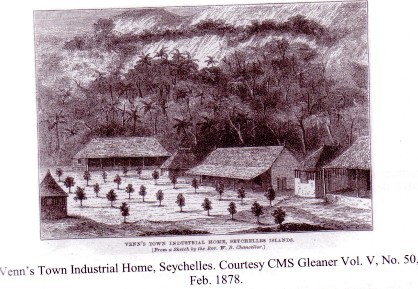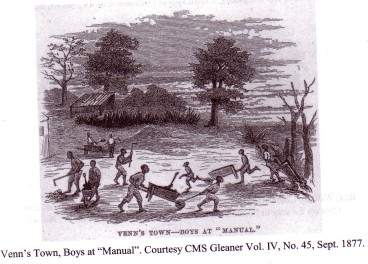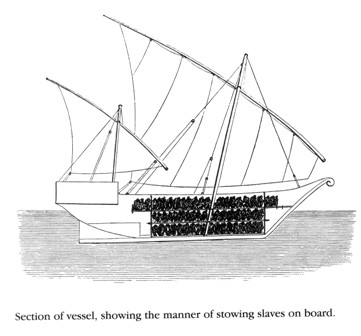The Mission ruins |21 April 2011

It’s an old place of mournful beauty and sweet peaceful gloom that arouses a titillating sensation of poignancy in the visitor. The Mission Ruins are actually the ruins of Venn’s Town, an industrial institution and sanctuary that accommodated children of liberated African slaves between 1876 and 1889.
Situated in the hills of Sans Soucis on the approximate east side of Mahé, the main island (151 sq km) of the Seychelles archipelago, the institution was named after Henry Venn (1796 – 1873) an Anglican missionary who in 1799 together with William Wilberforce (1759 – 1833), the English abolitionist, co-founded the Church Missionary Society to spread Christianity to the natives of Africa and Asia, as well as creating orphan asylums for children of slaves.
If today, the place lures locals and foreigners alike to experience the contemplative serenity of its hushed isolation and the poignant beauty of its resplendent gloom, it is its historical past that constitutes the quality of its melancholy charms. And although that past does not lie in remote antiquity, the chronology of events that brought about the existence of Venn’s Town goes back to the time of the 16th century – to the time of the egregious slave trade that was carried on by the nations of Europe for more than four centuries.
During the 16th century, Brazil – which the Portuguese colonised in 1530, and where slavery was not abolished until 1888 – and the Caribbean colonies of several European nations, developed a plantation economy and consequently slave labour was used on sugar cane, cotton, tobacco and coffee plantations.
From the early 16th to the late 19th centuries, some 10 million African slaves crossed the Atlantic in chains to become the foundation of the New World’s plantation economy.
An ignominious trend that likewise took place in many parts of the world including the Mascarenes. Thus, the demand for slaves tended always to exceed the supply. In addition to English, French, Dutch, and Portuguese slave traders, merchants from Sweden and Denmark also engaged in the lucrative business of buying slaves in West Africa and selling them to European planters in their respective colonies. Between about 1640 and about 1750, a great number of forts and trading-posts were established on the shores of West Africa and their ownership was constantly changing as the slave trading nations fought with each other in bloody attempts to gain supremacy in the trade. In fact, by the 18th century, England -- where slavery had been abolished since 1772 -- had gained the ascendancy in the West African slave trade.
English ships from London, Bristol and Liverpool carried cargoes of slaves to America and the West Indies.
Paradoxically enough, it was also during that time in 1787 when King George III (1738 – 1820) occupied the throne and William Pitt (The younger) (1759 – 1806) was prime minister that the British Government founded Freetown the capital of Sierra Leone, as a haven for freed slaves. As early as 1770, when the first French Settlers arrived led by DeLaunay to establish themselves on St Anne Island, they brought along a small contingent of slaves to clear the land and to build their settlement.
In 1772, when the administrator of Mauritius and Reunion Pierre Poivre (1719 – 1786) concocted his grandiose scheme to introduce cinnamon to Seychelles, it was slave labour that created the legendary Jardin du Roi, the spice garden at Anse Royale.
Later, in May of 1780 the ship that the French authorities mistook for a British vessel and consequently ordered the destruction of the spice garden lest the precious spices should fall into enemy’s hands was actually a French slave ship flying the British flag and bringing slaves to Mahé.
Before the British occupation, slaves from Madagascar and mainland Africa were brought to Seychelles to work on cotton plantations which occupied around 1,600 acres of land on Mahé. In fact, cotton was the first crop to be exported from Seychelles in 1796, two years after the first capitulation of Seychelles to the British.
Indeed, during the time that Jean Baptiste Quéau de Quincy (1748 – 1827), was commandant of the Seychelles, 1792 to 1811, slavery and slave trading in the Indian Ocean of the Seychelles was customary.
Ships from Mahé – Marianne, L’Etoile, L’Amazone, fetched slaves from the West African Coast and carried them to the Mascarenes. Zanzibar, lying 23 miles off the coast of Tanzania was for centuries the centre for Arab slave trading.
It continued to be a depot for slaves until the middle of the 19th century. At the beginning of the 19th century, an adult slave fetched £18. After prohibition of slave trading in 1807, the price rose to £120. It was the plantation owners who found themselves in a predicament. The least they could do in order to retain the workers that they so desperately needed to pick and husk coconuts which had gained economic supremacy in the islands, was to introduce a ‘moitié’ system under which African workers were given land to squat on in return for three days’ work a week.
In 1815, seven years after the British Parliament had passed the Abolition of the Slave Trade Act, there were about 7,000 slaves in Seychelles, among whom, many were the chattel of wealthy Mauritius planters who had moved to Seychelles to avail themselves of 
Nevertheless, the civil agent and Commandant Edward Henry Madge kept slaves and when he left Seychelles in 1826, he transferred 79 slaves to Mauritius where at Port Louis slaves brought over from West Africa were occasionally auctioned and employed on sugarcane plantations which the Dutch had started in the late 1630s. At that time, the ambiguous laws that prevailed attempted – at the expense of logic – to compromise between the rigorous definition of slavery which would make the slave merely an item of property, and the recognition of him as a person entitled to the protection of the state.
By 1827, Mauritius – which had been a depot for slaves since 1721 when the French took over – had almost 70,000 slaves and Seychelles had 6,520.
So clearly, in both of these countries which were ruled as single colony by the British, the African slave population had already, through miscegenation, began to have a fundamental impact on the creation of the Creole race. It is known that many slave owners who were single men had no qualms about siring children with their female slaves. It was in 1828 that the last slave ship, Victor, brought slaves to Mahé.
Besides being employed on plantations, slaves were also taken into the mountainous forests of Mahé to cut down timber for the ship building industry (Between 1810 and 1840, about 50 vessels, varying from 30 to 400 tons were built in Seychelles).
In 1835, when the Emancipation Act came into force, slaves were liberated and became apprentices to their masters who received indemnities at the rate of ₤30 per slave. This apprenticeship scheme lasted until 1839 because the plantation owners could not tolerate the fact that they had to pay their former slaves for their labour and more over many slaves decided to leave their former masters and become planters on their own account.
In Seychelles, the Emancipation Act saw the freedom of 6,521 slaves from a total population of 7,500 inhabitants. So it is not a hyperbole to say that most of the inhabitants then, were slaves!
Despite all sorts of restrictive measures at curbing the slave trade that came in the wake of the 1835 Emancipation Act, the illicit and obscene trade in human flesh from Africa seemed to have continued unabated because prices for slaves soared considerably. This was on account of the fact that the United States and Brazil where slavery was banned much later in 1865 and 1888 respectively, still offered a lucrative market for such an abominable business.
Many slave ships from Africa that passed through the Indian Ocean on their way to their destinations found the scattered distribution of the Seychelles archipelago propitious for the transfer of slaves to Arab dhows. However, sometimes during the mid 19th century, European anti-slavery sentiments became so widespread and vehement that the British government decided to take more drastic measures against those who persisted in slave-trading. Ships of the Royal Navy scoured the waters of the Indian Ocean, intercepted Arab dhows in the Mozambique channel and confiscated their cargoes of slaves which they brought to Mahé.
The first batch of 252 liberated slaves arrived at Mahé on HMS Lyra on May 14 1861. From then on until 1874 they kept arriving on various ‘slave busters’ such as the Nymph, Vulture, Ariel and Thefis. Between 1861 and 1874 a total of 2,816 African slaves were rescued from Arab dhows and brought ashore to Mahé. The men and women were allotted to different proprietors of estates to work in the expanding coconut and vanilla industries whilst the children lived vagrantly or were employed in households.

In recent years, the “cultural identity” of the Seychellois people has become a subject of great academic interest. It has brought with it a renewed impetus to understand more comprehensively the genesis of the Seychellois Creole race, and the recognition and interest in the fundamental role that slavery has played in the cultural history of the Seychellois population.
In the light of this, cultural and social anthropologists would have a legitimate claim in stating that a study of the historical development of the Seychellois Creole race can assure its validity only if it takes into account the genetic impact that slaves from the African continent who were brought to Seychelles have had in forming the Creole identity of the Seychellois race through miscegenation.
It was clear from the outset that the nature and the purpose of the sanctuary for the children of liberated slaves that the Christian Mission Society was proposing to establish up in the remote hills of Capucin would entail careful deliberation.
Therefore, it was only after protracted negotiations between the civil chaplain, Chancellor, the civil commissioner of Seychelles Charles Salmon (1874 – 1879) and Sir Arthur Phayre, the governor of Mauritius (1873 – 1875), that construction of the institutions began. The place at Sans Soucis where Venn’s Town was situated was known as Capucin because of the profusion of Capucin trees that once grew there. The settlement consisted of two dormitories measuring 100 by 25 feet, one for the boys and one for the girls, washrooms, huts for labourers, kitchens, workshops, a storeroom and a cottage for the school master and his family. The entire project amounted to almost £1,000. It was the civil chaplain William Bartlett Chancellor who had arrived with his wife and children from Mombasa in 1875 who undertook the task of overseeing its creation.
The adjourning lands which covered about 50 acres were turned into cocoa, vanilla and coffee plantations, the revenues from which went to the upkeep of the institution. When Venn’s Town opened in 1876, it accommodated 37 children, 20 boys and 17 girls. The children learned carpentry, gardening, bible stories and psalm-singing. The languages used for teaching were Creole, French and Kiswahili. During its existence, Venn’s Town had three superintendents: William Bartlett Chancellor 1876 – 1880, Henry Morris Warry, 1880 – 1885, Edwin Lucock 1885 – 1889. The institution also had a small cemetery situated on a mound further down. It is the resting place of the few African children who died of such mundane illnesses as dysentery or diphtheria but for which there was no remedy or medicament then. Among them also lie the two daughters of William Chancellor who died in June of 1879 and the two-year- old son of Edwin Lucock who died in April 1888.
As from 1879, most children who lived at Venn’s Town were not children of liberated African slaves but those born of African parents who worked as labourers on various plantations.
When the institution closed down in 1889, most of the children were integrated in African Schools. With its resplendent tropical forest scenery, sublime trees and majestic palms, Venn’s Town held many a visitor spell bound…
Marianne North (1830 – 1890) the famous globetrotting lady painter arrived in Seychelles on October13, 1882. Being a guest of Fanny Barkly, the wife of the civil commissioner Arthur Barkly, she was informed of the Church Missionary Society’s institution at Sans Soucis which had been established for the education and welfare of children of liberated African slaves.
She was so enthusiastic to see the place that in January 1883 she undertook the two-and-a-half hour ascent up to Capucin at Sans Soucis. “Crossing several streams, and through exquisite forest scenery”. She spent three weeks at Venn’s Town where she stayed with Henry Warry and his wife at the mission cottage. During the time that she spent there she made four magnificent paintings of the industrial school and its luxuriant surroundings of screw pines, palms and ferns.
These four paintings – numbered 467, 480, 486, and 495 – which give a vivid and nostalgic impression of the sublime beauty of the place are among the 44 paintings that she created during her three-month sojourn in Seychelles. These are among her 848 paintings which are on permanent exhibition in the North Gallery at Kew Gardens in London.
It was here at Venn’s Town that Marianne North saw the endemic capucin trees, the erstwhile profusion of which had inspired the name of the place. The tree which has a reddish brown bark and grows up to a height of 20m was once a source of timber which was exported from Mahé during the early 19th century. It is because its seed which is divested of the pericarp and resembles the hooded head of a capuchin monk that the tree has earned its vernacular name.
After Marianne North had sent specimens of the fruit to the world-reknowned botanist and curator of the Royal Botanic Gardens at Kew, Sir Joseph Hooker (1817-1911), she was delightfully amazed to be informed that a new genus, a taxonomic category, had to be created for that particular tree which Hooker had named Northia Hornei in her honour! But sadly enough, many capucin trees at Sans Souci were already in various stages of decay when Marianne North visited.
Much later – from 1909 to 1920 – during a protracted reforestation programme on Crown Lands, 2,335 capucin trees were planted. Nowadays, there are few of these trees left on Mahé because during the 1950s, there was a large scale exploitation of its timber.
In her autobiography ‘Recollections of a happy life’, which was published posthumously in 1892, Marianne North says:
“The situation of Venn’s Town is one of the most magnificent in the world, and the silence of the forest around was only broken by the children’s happy voices.” Indeed, while she was there, 60 children lived at Venn’s Town.
Since the creation of the Industrial Institution of Venn’s Town was the initiative of the church Missionary Society as part of its Anglican ministry, the religious aspects and implications of the institution pertaining to the objectives of the Anglican Church cannot be disregarded.
The establishment of Venn’s Town in 1876 was at a time when both the Anglican Church and the Catholic Church were fervently promoting their respective faiths. Despite the fact that the first chaplain to visit the Seychelles in 1832 when slavery was as its zenith was an Anglican, William Morton, who baptized 500 inhabitants and also the fact that all the British civil commissioners were all protestant did not necessarily give the Anglican Church the upper hand.
Most of the plantation owners who were of French lineage were Catholic and after 1851 they had their workers, who were all former slaves, baptised in the Catholic faith. By 1891 the protestant population of Seychelles was 2,636 compared to 13,504 Catholics.
Nevertheless the Mission Ruins of Venn’s Town at Sans Soucis remain an enduring testimony of the altruistic concern that the then burgeoning Anglican Church in Seychelles had for those who were victims of abject human depravity.
During much of the 20th century – in fact until the opening of the airport in 1971 which launched the era of the tourism industry – Seychelles relied heavily on an agricultural economy – the foundation of which it is correct to say – had been created by the toil and sweat of African slaves. The bountiful harvest of coconuts (over 26 million picked in 1913) cinnamon (14 tons in 1937) and vanilla (3,245 kilos in 1927) that the Seychelles experienced over the decades is attributable to the hard work of hundreds of labourers who lived an existence of hardship and poverty.
By admitting that plantations in Seychelles together with those of other British territories during the days of Empire accounted for 50% of colonial wealth overseas is to acknowledge a fact of History.
Indeed, during the Industrial Revolution in England, revenues from colonial plantations were channeled through hundreds of banks and the stock exchange –founded in 1773 – into new industrial processes. In 1937 the foreign trade of the colony of Seychelles amounted to R2,765,416.
The Mission Ruins is a national monument, and as a popular tourist attraction it is one of the most visited historical sites in Seychelles. Sadly enough, the rows of centennial Sandragon (Pterocarpus indicus) trees that dated back to the days of Venn’s Town, and for almost a hundred years after that constituted one of the most charming features of the place have succumbed to the ravages of moths in their foliage and a fungus infection in their trunks. A horrible pestilence that occurred at the very end of the 20th century.
A viewing lodge at the end of the hill where Venn’s Town once stood affords a magnificent panoramic view of the western seascape and coast lands.
It was built in early 1972 by the Forest Division to a design by the Town Planning Department.
The viewing Lodge was inaugurated on March 20, 1972 by Queen Elizabeth II and her husband the Duke of Edinburgh when Her Majesty came to inaugurate the Seychelles International Airport.
The historical significant of the Mission Ruins resonates deep into the very core of the Seychellois nature. It can be legitimately asserted that the ancestors of more than a few of today’s generations were among those African children who lived up there at Venn’s Town from 1876 to 1889. This is one of the main reasons, perhaps, why the place in all its forlorn dilapidation and poignant desolation is cherished as a shrine to human events that had an impact on the development of Seychelles during the early years of its civilisation.






